#cultural history
Note
I was reading your yeomen tag and saw the term knave refering to someone bellow a yeoman. But what is a knave?
As I’ve discussed in the past, a lot of our insulting terms for people started out as class signifiers:
a villain was originally a villein (another term for serf).
a knave was a servant (often the "knave" and the "knight" were opposing pairs) but also a low-status and thus dishonorable person.
likewise, "flunky," "minion," "lickspittle" and similar terms all originally were different (mostly insulting) terms for servants.
"vagrants," "vagabonds," and "sturdy beggars" were all descriptions of homeless people, either who were seen as inherently criminal and dangerous because they were disconnected from the feudal system. There is a strong crossover to anti-Romani/anti-Zigany slurs, as well as the "rootless cosmopolitan" variant of anti-semitism, in this category.
similarly, "bumpkins," "yokels," "rubes," "hicks," "rednecks," etc. were all insulting terms for people from rural areas, usually denoting their lack of education, sophistication, and their working in outdoor manual labor.
for some gendered versions, "sluts" and "slatterns" originally had connotations of being dirty, unkempt, and being a low-ranked servant like a scullery or kitchen maid (i.e, they're dirty because they're doing "the dirty work").
upper-class Brits still use "pleb" (plebian) as an insult today.
159 notes
·
View notes
Photo
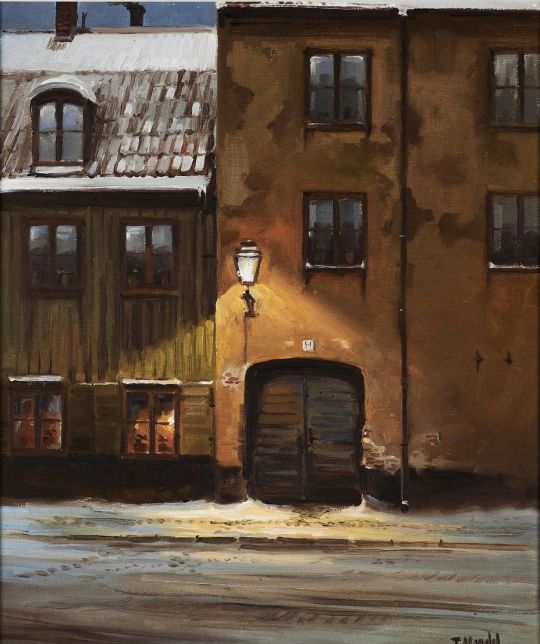
Fjällgatan 38 - Tomas Mandel
Swedish, b. 1923 -
Oil on canvas , 59 x 49 cm.
#Tomas Mandel#swedish artist#street Stockholm#Fjällgatan 38#Stockholm neighborhood#stockholm architecture#18thcentury#old buildings#Södermalm#cultural history
431 notes
·
View notes
Text
Why human culture became monogamous
Let me talk about one thing: The reason for the prevailance of monogamy these days. Because I think a lot of people are not quite aware of this.
If you are monogamous, this is not a slight against you - it is simply about the history of it.
Because here is the thing: Homo Sapiens as a species is not monogamous. And all that we can say about our biology so far is, that we are not even a seasonally monogamous species.
To explain: There are species, that are monogamous, or seasonally monogamous. In a monogamous species, animals mate for life. And once they have mated, they will not be interested in any other animal anymore. We actually see this behavior most often in different birds, like some swans and penguins.
There are also species, who are seasonally monogamous. Again, this is mostly seen in birds. Seasonally monogamous species mate once per mating circle and then again do not experience any interest in potential other partners.
The reason that this is mostly seen in birds is probably an evolutionary adaption based on the fact that with birds at least one partner needs to keep the eggs warm, so that the other partner needs to bring in food to the nest.
Homo Sapiens meanwhile are not that. Homo Sapiens do experience attraction to people other than their current partner. And in fact there is a lot of biological evidence, that biologically speaking we have evolved to live in groups and within these groups just fuck whoever.
Biologists have pointed out that the fact that our bodies produce oxytocine in response to sex, which builds trust and produces generally positive feelings towards others. This does seem like an evolutionary adaption to produce closer knit groups.
We can say this, because we can see the same in bonobos - one of our closest relatives in the animal kingdom.
Biologists also assume, that our moaning during sex is actually an adaption to invite others to join us.
And of course we do just know that we will just randomly fall in love and feel attracted to other people independent of our romantic status right now.
So, why is our society geared towards monogamy?
The answer is simply: Patriarchy.
See, monogamy is mostly a result of the patriarchy. Which is also why monogamy mostly sprang up in patriarchal cultures, while not being that prevalent in matriarchal or more egalitarian cultures.
Patriarchy only emerged once we settled down and started owning land. Why exactly it sprang up, we do not really know, but we do know that it ran into one problem: It relied on the patrilinear succession and inheritance. And that is a bit more complicated than matrilinear succession, right?
Because a woman will always know who her children are. It is quite easy to know, given that the woman is the one pressing the child out of her uterus.
A man meanwhile? Well, he cannot know who his children are in a world before paternity tests. At least not unless he makes sure that the woman birthing the child has slept with nobody but him. And hence: Monogamy. At least enforced monogamy for women.
This is also what led to all those other ways of men controlling women. Controlling how they dress and shaming them for whatever thing they might do, that men find attractive. Because it all has to do with this patriarchal fear of not knowing whether a child is yours or not.
Of course it has to be noted that originally this only led to polygyny. So a man, who would take several wives, but control the wives so that they would not sleep with another men. But we do assume these days, that the reason it led to monogamy was, that polygyny made the societies too instable, because it would naturally mean, that some men would not have any women and that was not good.
Hence... Monogamy was what people started to settle on more and more. Including this idea that men somehow owned women.
If you feel more comfortable with monogamy... Sure, fine. Good for you. But I think we really should speak more openly about the fact, that monogamy is something that is based completely in the patriarchy and in the end mostly exists to suppress women. For no other reason.
38 notes
·
View notes
Text

“A profound meditation on what it meant to be a Jewish body in a Roman world of bodies. By taking seriously both Roman Jewishness and Jewish Romanness, Eliav casts new light on what life, in all its mundaneness and intimacy and temptation, was like as a Roman Jew. Eliav makes a powerful argument for the integration of rabbinics and classics around the steamy space of the public bath.”
81 notes
·
View notes
Text
Lauren Booth: "Now here's another proof that the Zionists do not belong there. If you go there and you feel this, much less if you feel you own the land, could you destroy 750,000 ancient olive trees? Could you absolutely decimate an are where ancient stones where prophets are and where profits have walked? No. Not if you believed in any way in a love for that land. The Zionists are alien bodies, are viruses in a beautiful body - they're a virus because a virus kills. A virus does damage. And people are going to freak out : 'oh my god, you're calling them viruses ' but - show me what good they've done for the land of Palestine. ..."
She's completely right.
You can't claim to have a spiritual connection to the land, that land and it can only be that land, because of the spirituality connection, and then destroy it.
If you base your entire claim on the land on a spiritual value, you render your entire claim void the second you don't respect that land that you claim is yours through a spiritual connection. The second you destroy its native plants and habitats, native animals, ancient buildings and architecture directly connected to that spirituality you claim is so sacred, and is the whole reason for this, you reveal yourselves.
The ancient buildings, architecture, the land and nature on it, the very things that are the cultural history of that spirituality that should by definition be sacred to you, the second you disrespect and destroy that, you expose the truth of your intentions. And what this has always been about.
Decolonise Palestine now
Full interview
youtube
#Palestine#Free Palestine#Decolonise Palestine#Israel is a terrorist state#Zionists#Zionism#colonization#war crimes#ethnic cleansing#Genocide#Lauren Booth#Land#Palestinian Land#Illegal invasion#Illegal occupation#Illegal settlement#Illegal Israeli expansion settlements#Destruction#Cultural imperialism#Cultural history#Religion#Youtube
21 notes
·
View notes
Text
So, according to this article 34,000 new digital images of medieval items were uploaded on this site:
https://www.europeana.eu
But it's not just medieval stuff, it's a lot more! Search or pick a theme and explore. It's a great resource of european historical items, documents and images, for writing, art, researching and for whatever else strikes your fancy. You got music, maps, art, fashion, newspapers, magazines, manuscripts, sports items etc.

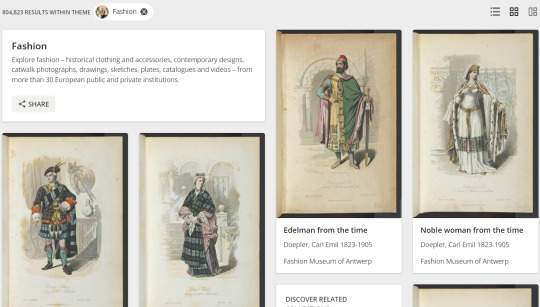
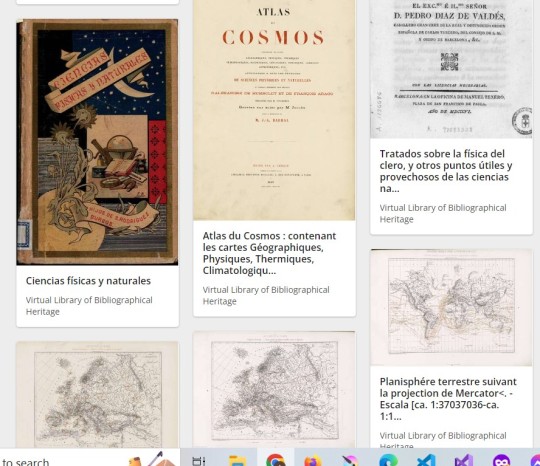

The organization and filtering system is pretty great too! You can filter by language, country of origin, materials, techniques (depending on theme of course) and many more. Also, you can even filter by usage rights

Give it a go, have fun!
Edit with other interesting things I found under a read more because it's getting kinda long, but tl;dr browse by topics, read articles and download some free colouring books
Edit:
On the collections tab you can find more topics by which you can browse and you can even make your own galleries, like your own private museum collection 💜

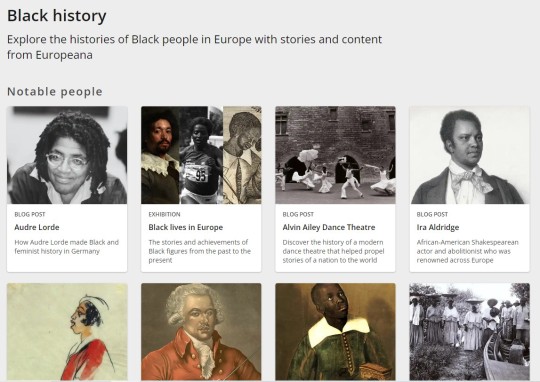

They even have a section where you can download colouring books
#resources#digital library#art#history#fashion#archaeology#european history#references#europeana#science history#cultural history#archives#museum collections#i saw lots of posts on tumblr with artworks linking to the site#but maybe a bit of info on the site itself will help too
251 notes
·
View notes
Text


For almost 10 years between 1929 and 1938 theoretician and architectural historian Sigfried Giedion worked on a book project that only peripherally dealt with architecture and eventually also remained unpublished: „Die Entstehung des heutigen Menschen“, the emergence of modern-day man. It was an ambitious project spread over approximately three volumes dealing with different topics related to the emergence of modern-day man. In Giedion’s archive at the ETH Zurich the material related to the book project has survived and Sokratis Georgiadiscin collaboration with Almut Grunewald edited and annotated them. The result is has recently published by @gtaverlag
In the first volume, entitled “Construction and Chaos”, Giedion recounts the discoveries and inventions from the 17th century up to the First World War, effectively the emergence of the industrialized world and the human being within it. It is the most complete of the three volumes and through Georgiadis’ introductory text receives additional political, sociological and ultimately intellectual context that especially with regard to the Industrial Revolution is helpful.
In the second volume Giedion finally deals with architecture, namely in the form of social building tasks, and thus one of the most discussed topics of modern architecture in the first half of the 20th century. For this Giedion collected examples of German, French and British housing designs, a hint at his overall focus on Europe.
In the shortest fragment, dealing with the prevailing taste, Giedion takes to the popular art of the 19th century and reveals his bourgeois perspective on his research subject.
Although sympathetic with Giedion, Georgiadis keeps his distance and critically discusses his conceptions and also uncovers his shortcomings, e.g. the underlying assumption that a division between thought and feeling characterized the industrialization: Georgiadis proves that this notion is insufficient to explain the actual hardships of the industrial labor forces and typical of a bourgeois point of view. On the other hand the book closes a gap in Giedion’s list of publications and due to its unfinishedness offers interesting perspectives on a major thinker’s trains of thought and research methods. A fascinating read, most of all because of Georgiadis’ brilliant annotations.
20 notes
·
View notes
Text

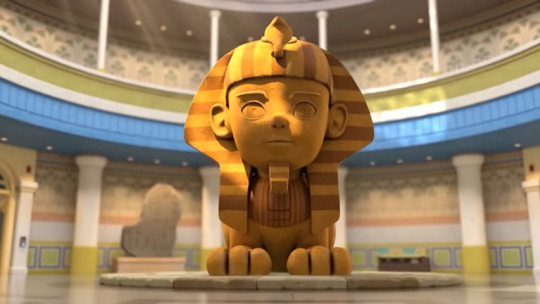
Architecture and Monuments: Great Sphinx of Giza - Egypt
The Great Sphinx of Giza is a limestonestatue of a reclining sphinx, a mythical creature with the head of a human and the body of a lion. Facing directly from west to east, it stands on the Giza Plateau on the west bank of the Nile in Giza, Egypt.
The Sphinx is the oldest known monumental sculpture in Egypt and one of the most recognizable statues in the world. The archaeological evidence suggests that it was created by ancient Egyptians of the Old Kingdom during the reign of Khafre (c. 2558–2532 BC).
A special feature of the Sphinx is its actual lack of a nose. The circumstances surrounding it about being broken off are uncertain, but close inspection suggests a deliberate act using rods or chisels. Contrary to a popular myth, it was not broken off by cannonfire from Napoleon's troops during his 1798 Egyptian campaign. Its absence is in fact depicted in artwork predating Napoleon and referred to in descriptions by the 15th-century historian al-Maqrīzī.

It is unknown how the name of the Sphinx came to be, due to propably multiples origins, for example of its creator of the Old Kingdom, as the Sphinx temple, enclosure, and possibly the Sphinx itself was not completed at the time, and thus cultural material was limited. In the New Kingdom, the Sphinx was revered as the solar deity Hor-em-akhet (English: "Horus of the Horizon"; Hellenized: Harmachis)
The commonly used name "Sphinx" was given to it in classical antiquity, about 2,000 years after the commonly accepted date of its construction by reference to a Greek mythological beast with the head of a woman, a falcon, a cat, or a sheep and the body of a lion with the wings of an eagle (although, like most Egyptian sphinxes, the Great Sphinx has a man's head and no wings). The English word sphinx comes from the ancient Greek "Σφίγξ" (transliterated: sphinx) apparently from the verb σφίγγω (transliterated: sphingo / English: to squeeze), after the Greek sphinx who strangled anyone who failed to answer her riddle.

Over the centuries, writers and scholars have recorded their impressions and reactions upon seeing the Sphinx. The vast majority were concerned with a general description, often including a mixture of science, romance and mystique.
From the 16th to the 19th centuries, European observers described the Sphinx having the face, neck and breast of a woman. Examples included Johannes Helferich (1579), George Sandys (1615), Johann Michael Vansleb (1677), and some others following it. Most early Western images were book illustrations in print form, elaborated by a professional engraver from either previous images available or some original drawing or sketch supplied by an author, and usually now lost. Seven years after visiting Giza, André Thévet (Cosmographie de Levant, 1556) described the Sphinx as "the head of a colossus, caused to be made by Isis, daughter of Inachus, then so beloved of Jupiter". He, or his artist and engraver, pictured it as a curly-haired monster with a grassy dog collar. Athanasius Kircher, however, depicted the Sphinx as a Roman statue
#super wings#super wings cultural#ancient monument#historical architecture#cultural monument#cultural history
11 notes
·
View notes
Text
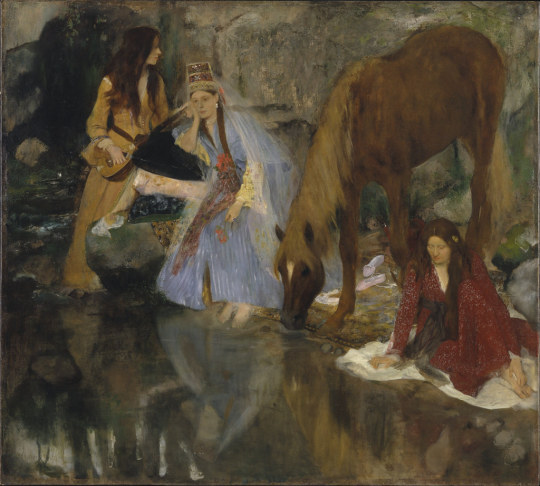
Portrait of Mlle Fiocre in the Ballet “La Source” (c.1867-1868) • Edgar Degas (French, 1834-1917) • Oil on canvas • Brooklyn Museum.
Edgar Degas’ painting, Mlle Fiocre In The Ballet The Source, showcases the renowned ballerina Eugénie Fiocre in her role as princess Nourreda in the ballet La Source - an elaborate production, with exotic costumes and sets, that also included bodies of water onstage as well as livehorses. Degas depicts the famous ballerina at center in pale blue. Painting the dancers at a pause in their rehearsal—note the cast-off ballet slippers—Degas captures them at a transitional moment between the imagined place and time of the ballet and the private reveries of the present. Created in 1867-68, this piece of art exemplifies the impressionism style, capturing the beauty of nature and the female form intertwined during a ballet performance. Degas was known for his pursuit of this element and moved beyond creating mere records of performances to opportunities for capturing new elements.
Currently housed in the Brooklyn Museum in New York City, this painting remains popular among art enthusiasts for its stunning scene of a ballet performance and its significant contribution to impressionistic art.
~ arthive.com, internetarchives.org
#art#painting#fine art#art history#19th century art#impressionism#degas#ballet#women in paintings#french artist#cultural history#ballet in art#dancers in artworks#french painter#historical painting#brooklyn museum
27 notes
·
View notes
Text









Today its been studies all day. And some time to just relax, decorate the house and enjoying the day. Finally some tomtegröt (porridge). In old Sweden, porridge was often put out for the house elf at Christmas (he looked like a smal gray santa). ✨
In nordic mythology, the house elf is a small being that looks like an old man with a long beard. They are usually dressed in gray and have a gray or red beanie. House elves are strong and good at work. They live close to people, usually in a stable or a barn, but sometimes in the same house as the people. A house elf is grumpy and doesn't want to be seen. But secretly he keeps track so that the people are kind to the animals and take care of the farm in a good way. If the people take care of themselves, they can get help from the house elf with many of the chores on the farm, and the elf creates security on the farm. But if the people, for example, don't give the animals enough food, they can suddenly get a kick in the ass, or an slap from someone they can't see. Then it's the house elf who is on the move and wants them to tighten up. A house elf can be several hundred years old and usually stays on the same farm for several generations of owners. Elves are basically quite friendly and caring creatures, as long as you don't annoy them. To show appreciation and keep house elf happy, people could set out a dish of porridge with a dollop of butter in it on Christmas Eve. Then the house elf was happy. ✨
A translation from Swedis radio, allways loved folklore.
December 2023 ✨❤️
Avesta, Dalarna, Sweden
#sweden#swedish#my photos#swedish folklore#swedish culture#culturalheritage#cultural history#nisse#tomtenisse#tomte#dalarna#gaylife#swedish food#december 2023#julmys#god jul#swedish home#swedish history#xmas decorations#christmas tree#christmas decorations#food#homesweethome#holiday#good things#swedish tradition#swedish traditions#my life#my home#enjoythelittlethings
15 notes
·
View notes
Note
Maybe this is too broad, but wondering if there's a better term than "conspiracy theorist" to describe some large figures in the ongoing national discourse? Not that "fluoride in the drinking crowd" were serious thinkers or total harmless, but am I alone is finding "conspiracy theory" too quaint and mild to describe how mainstream rather fringe these things are and also how totally evidence-free and something just plain dumb they can also be?
I don’t think conspiracy theories have ever been quaint and mild.

Think about the history of antisemitism from medieval blood libels to 19th century theories of Jewish financial cabals to the “Protocols of the Elders of Zion” dreamed up by Tsarist agents-provocateur that took the theory global and spawned untold numbers of imitators, to Hitler’s invention of “Judeo-Bolshevism” that married traditional antisemitism to anti-Communism and nationalist populism. Conspiracy theories one and all, but fully capable of spawning pogroms and fascist dictatorships.
Likewise, we think of Anti-Masonic or Illuminati conspiracy theories as self-evidently ridiculous and harmless, but we forget that they were used by cultural conservatives in church and state to wage culture wars on the Enlightenment, liberalism, secularism, democracy, every revolution from America to France to 1848 and beyond, feminism and almost every social movement of the 18th and 19th century. People died or were surveilled or were sent to prison, political parties were formed or banned, and conservatism itself was founded in the name of “poisoning the minds of the lower orders” to inoculate them from the influence of secret societies.
As Dan Olsen has shown, even seemingly benign conspiracy theories like the JFK assassination cover-up or the Moon landing was faked or the earth is flat can hide much more malign motivations, just waiting for the opportunity to radicalize and proselytize:
youtube
#history#historical analysis#cultural history#conspiracy theories#conspiracies#anti semitism#illuminati#freemasons#flat earthers
140 notes
·
View notes
Text


Giving chocolates is a way to show your love on Valentines Day. Human beings have been in love with chocolate and the Cacao tree (Theobroma cacao) for thousands of years, and today we will learn about the romance of culture and chocolate.
Although Cacao is most famously associated with Mesoamerican cultures, genetic studies indicate that Cacao was domesticated by indigenous Americans around 5,300 years ago in the Upper Amazon region. From there, Cacao cultivation spread north to Mexico. The Cacao fruit pulp was more commonly consumed in South America in Pre Columbian times while the Mesoamericans invented the technique of fermentation and roasting to utilise the Cacao nibs.
Archaeological evidence, such as chemical residues on ancient pottery shards, pinpoints the first use of Cacao drinks in Mesoamerica around 1600 BCE. By the time of the Classical Mayan civilization (250-900 CE), ground cacao nibs were mixed with water and spices by careful pouring between vessels to make a nourishing and invigorating hot drink which was consumed by people of all social classes. In the later Mexica (Aztec) civilization, cold cacao drink or xocoatl (bitter water in Nahuatl) exquisitely flavoured with flowers, fruits, chillies, and spices was reserved for the elite and ceremonial occasions. Cacao seeds were used as a form of currency for trade and barter during the Mexica Empire.
After the conquest of the Mexica Empire by Spain in 1521, cacao was one of the many new plant-based foods brought to Europe. In Spain, the locals of Andalusia experimented with the spicy xocoatl by adding cane sugar and dairy ingredients. It is said that drinking chocolate was so universally popular from the 17th century to the late 19th century that it prevented coffee from becoming mainstream in Spanish culture. Drinking chocolate caught on in the rest of Europe in the 1600’s but it was not until the mid 19th century that innovation in processing and chemistry allowed the invention of solid chocolate candies. Cadbury chocolate company is credited with marketing chocolates as a token of love for Valentines Day in 1868.
Chocolate in the modern world is not always a sweet story. Today, approximately 70% of the world’s cacao is produced in West African countries like Ghana and the Ivory Coast. Sadly, exploitative practices like child labour and enslavement are still rife in these countries’ Cacao farms. Chocolate lovers can help by buying Fair Trade certified chocolate products and other responsibly grown cacao products. Fortunately, cacao can be grown in sustainable agroforestry alongside native rainforest trees especially in Latin America. Cacao’s sacred and medicinal properties are experiencing a renaissance among “chocolate shamans” around the world who drawn upon indigenous knowledge to make the ethical production and mindful consumption of cacao a healing spiritual experience.
Humanity and Cacao have a long-lasting love that continues to evolve over time, and has the potential to benefit plants, people, and the planet. Ponder the storied history of Cacao if you indulge in chocolate this Valentines Day.
Image credits to Mexicolore
#katia plant scientist#botany#plant biology#plants#plant science#cacao#cacao tree#trees#economic botany#culture#cultural history#chocolate#drinking chocolate#spanish history#native american#mesoamerica#aztecs#mayans#mesoamericans#mexico#ceremonial cacao#shamans#fair trade#chocolates#food history#west africa#cacao nibs#cacao beans#aztec history#colonialism
9 notes
·
View notes
Photo


Eskimek ne güzel, eksilmedikçe...
#nazım hikmet#şiir#photographer#street photography#old building#old door#travel photography#gezgin#objektifimden#my photography#historical places#cultural history#photography art#traveller
68 notes
·
View notes
Text

"The main chapters focus on a specific theme, a type of monster or representation of monstrosity, and consist of a contextual essay synthesizing recent scholarship on that theme, excerpts from primary sources and a bibliography of additional primary and secondary sources on the topics addressed in the chapter. In addition to building upon the wealth of scholarship on monsters and monstrosity produced in recent decades, the book engages with the current fascination with monsters in popular culture, especially in movies, television, and video games. The book presents a survey of medieval monstrosity for a non-specialist audience and provides a theoretical framework for interpreting the monstrous."
17 notes
·
View notes
Text
2023 Reading Log pt. 14
Where the hell did November go?

66. New World Monkeys: The Evolutionary Odyssey by Alfred L. Rosenberger. In the introduction, the author laments that there aren’t any good books outlining the evolution and ecology of the New World Monkeys. If that's the case, there still aren’t. This book does alright by the ecology part—it has good summaries of the anatomy, behavior and feeding interactions of the covered monkeys. But the evolution is a mess. Rosenberger’s take on the evolutionary relationships between the animals covered here is iconoclastic, to say the least. He distrusts molecular phylogeny, uses synapomorphic characters that are basically just vibes, and has an entire chapter dedicated to lambasting the idea that any mammals could disperse across the Atlantic Ocean from Africa to South America (the consensus explanation) in favor of a hypothesized trek through Greenland and North America that has no evidence and still requires open ocean crossings. This was an incredibly frustrating experience to read, because there’s enough good content among the dross that I didn’t want to just abandon it.

67. Seaweeds of the World by John H. Bothwell. The weakest of Princeton University Press’ “X of the World” series. For one thing, the subtitle is usually “A Guide to Every Family”, whereas here it’s “A Guide to Every Order”. The book’s general coverage of seaweeds is pretty good—it explains why “seaweed” is a polyphyletic category but still useful in common English, explains the anatomy and the complex life histories of seaweeds. But the actual coverage of groups is lacking. Again, it doesn’t cover every family. And it’s more interested in seaweeds of economic importance than it is in their actual ecologies. Plus the writing is just kinda boring. This is the first entry in this series I do not recommend.

68. Lapidarium: The Secret Lives of Stones by Hettie Judah. Now this is more like it! This book is a series of short essays about stones and their cultural impact. I’m a sucker for cultural histories in general, and this is a very good one. I especially liked that it doesn’t just cover gemstones, as I originally expected, but also stones used in art and architecture, resources like coal, and the use of earthworks in religion. The focus is much more on the culture than the geology, but the book does discuss things like deposition of sediments and how metamorphic rocks yield gemstones in explaining why certain places have certain rocks. The book is also lovely to look at, with minimalist bands of color along the sides of the pages in the hues of the stones covered in that chapter.

69. Monsters and Monarchs: Serial Killers in Classical Myth and History by Debbie Felton. I was excited for this one. I had read Felton’s chapter in Monster Anthropology, which suggested that Greek traveler’s tales about werewolves and the murderous robbers encountered by Theseus in myth were both expressions of cultural fears about serial killers. Unfortunately, that article already covered the bulk of Felton’s actual argument and evidence, and this book is those 20 pages fluffed to 200. The only other really good material is some coverage of the distinction between Greek and Roman attitudes towards law and order, and what “counted” as murder in each society. The rest of it is handwaving and extrapolation from very little data, with just about every instance of mass killing that we have records of, from political uprisings to court intrigue, being taken as the work of a possible serial killer. Plus, the author is a Freudian, so we have to hear about coded references to rape and sexual violence in stories where there really aren’t any. Sometimes a bed where you get your legs cut off is just a bed.
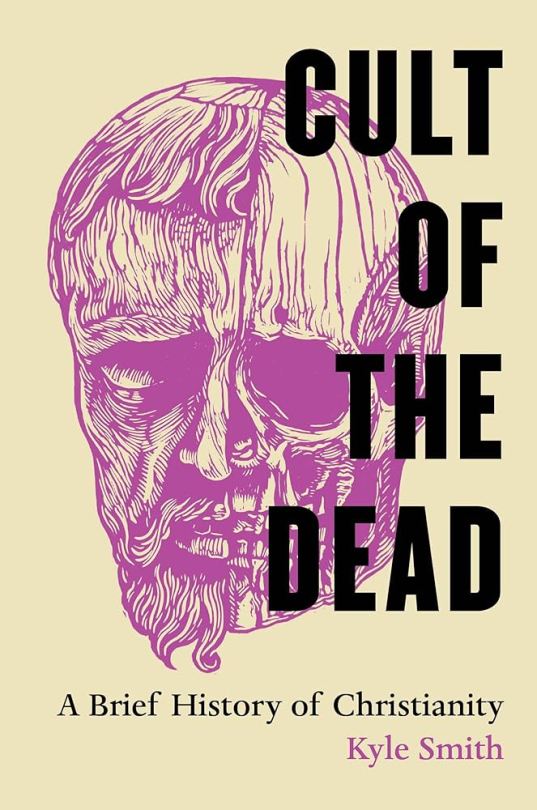
70. Cult of the Dead: A Brief History of Christianity by Kyle Smith. They say you can’t judge a book by its cover, of course, but that title and that cover made an instant sale for me. I’m glad it did, too, because this is a good one. An explanation of the importance of martyrdom to Christianity, it does an excellent job of explaining why, exactly, so many people were willing and eager to die for their faith, and how this persisted in building a persecution complex among the dominant European religion for centuries. The book avers from discussing the present day for the most part, tapering off with the work of reformist Catholics poring over the many, many legends about saints and trying to determine which, if any of them, represent actual historical events rather than religious fictions. Other topics covered include the trade in relics, the role in martyrologies in shaping the modern calendar, and how women could most easily play a role in the Church through the mortification of the flesh. The book is eminently readable and very well illustrated.
#reading log#christianity#comparative religion#seaweed#classical mythology#classical greece#classical rome#new world monkeys#evolution#ecology#geology#cultural history
8 notes
·
View notes
Text
At least 14 libraries have now been badly damaged or destroyed entirely by Israeli forces since October 7.
This includes the Gaza University Library (which was destroyed on October 9), the IBBY Children in Crisis Library (which had previously been destroyed by an Israeli airstrike in 2014), the Diana Tamari Sabbagh Library (which contained tens of thousands of books and had been sheltering hundreds of displaced Palestinians before it was shelled by Israeli forces on November 25), and the Al-Israa University Library and National Museum (which was looted by the Israeli military before it was destroyed by controlled demolition on January 18).
The Central Archives of Gaza (which contained 150 years of records pertaining to Gaza’s history) and the Great Omari Mosque (which contained one of the most significant collections of rare books in Palestine) have both also been destroyed.
4 notes
·
View notes